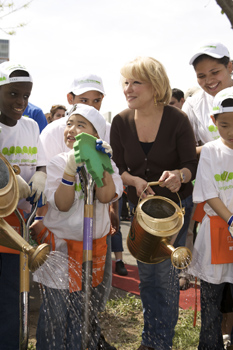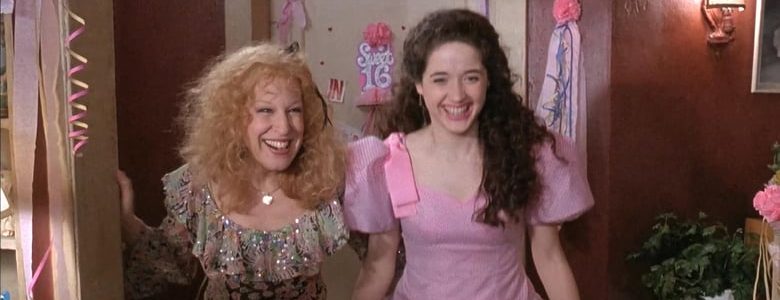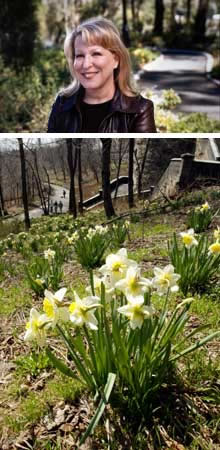 NYRP celebrates 15 years of conservation
NYRP celebrates 15 years of conservation
Community News
Written by Daniel P. Bader
Tuesday, September 21, 2010
In 1995, world famous entertainer Bette Midler drove down the West Side Highway with her daughter Sophie in tow. The shores of the Hudson River were blanketed in garbage. Car parts, tires, furniture, littered the forest floor.
One morning Midler pulled over, wandered straight into Fort Washington Park and began collecting garbage.
“She [Bette] just couldn’t believe this was being allowed to fester in the public realm,” said Amy Gavaris, New York Restoration Project’s Executive Vice President. “In the beginning, we just acted.”
Midler, who rose to stardom as a bathhouse and cabaret singer but is perhaps best known for her roles in the movies “The Rose” and “Beaches,” spoke about the problem with Charles McKinney of the New York City Department of Parks and Recreation. He suggested she visit the rest of the parks of Northern Manhattan. She did, and what she saw propelled her to do something.
“Bette said ”˜let’s be the conservancy of forgotten places,’” said Gavaris.
That first pitstop Midler made along the highway led to the founding of New York Restoration Project.
According to Gavaris, one of NYRP’s first staff members, the organization started by simply doing what its members thought needed to be done. Initially, NYRP planned to work on parks in Northern Manhattan then move to other areas of the city. However, it became clear that more was needed uptown. While NYRP works in all five boroughs, it still maintains a keen focus on Northern Manhattan. For instance, the nonprofit operates the New Leaf Café Restaurant and Bar in Ft. Tryon Park to help sustain its operation.
It was a unique epoch in New York City history that birthed NYRP.
“The city was going through enormous financial upheaval, social upheaval,” said Gavaris. “It was clear some neighborhoods were going to be left out.”
A preliminary goal? Make sure the “forgotten places” don’t get left out.
Since that time, the city’s park space, along with its financial and social climate, has changed tremendously, by all accounts. In step with the city, NYRP has shifted in its strategy and focus.
While the organization began by going into parks, cleaning and trying to do what was needed, it now places more emphasis on planning and building partnerships with other organizations. Since 2007 it has been a key partner in the city’s effort to plant a million trees before 2017.
According to the organization’s mission statement, NYRP is “dedicated to reclaiming and restoring New York City parks, community gardens and open space.”
Gavaris said that NYRP has always gone beyond the original mission statement. The organization has taken advantage of opportunities as they have arisen.
Since its start, it has spread to locations in all five boroughs. Gavaris said it wasn’t that Midler wanted a big organization, but that she knew that the challenge was huge.
“People who live in the outer boroughs deserve to have beautiful green spaces just as people who live near Central Park have the benefits of the Central Park Conservancy,” Midler said in a written response to three questions.
Indeed, Gavaris credited Central Park for her decision to go into landscape architecture, planning and design. Gavaris said she grew up playing in Central Park and that for her, it was a backyard.
NYRP is seeking to bring that kind of experience to kids all over the city.
“I know we have raised the consciousness of children who have never had the privilege of seeing an earthworm up close, or a tomato on the vine. When I see the ”˜light go off’ in their eyes, it’s very moving. I love that,” Midler said.
As NYRP moves forward at its 15 year mark, the organization plans to extend the “privilege of seeing an earthworm up close” to even more children. NYRP has hired Amy Freitag as its new executive director. Freitag will begin Oct. 1.
While Freitag’s leadership direction and the thrust of her work with NYRP remain to be seen, Gavaris said she expects education to be a major focus.
NYRP has already begun making changes in its education programming in the past few years. Akiima Price, NYRP’s chief of education and programs, was hired four years ago. Price said previous educational programs didn’t make the best use of the space.
Price helped create “Nature in my Neighborhood,” NYRP’s educational programming that targets schools and neighborhood residents close to NYRP green spaces. The program aims to empower youth and communities to “identify, create and care for nature in their neighborhood.”
“It’s bigger than just gardening,” said Price. “It can precipitate lifestyle change. They’re essentially a different person, with a different outlook.”
Price said the effort to get kids outdoors and into nature is larger than NYRP or New York City for that matter. The movement seems to be nationwide, if not worldwide.
“The things we’re doing are setting us up to be a national model,” said Price.
Price said she recently represented NYRP at a White House conference on the great outdoors. While much of the conference focused on rural outdoor spaces, many people from urban organizations attended. By the end of the conference, talk had shifted to the urban outdoors.
In addition to an emphasis on education, NYRP will continue to concentrate substantial effort on Northern Manhattan.
Much of NYRP’s work in recent years was focused on turning an illegal dumping ground behind P.S. 5 in eastern Inwood into Swindler Cove Park. Gavaris said the next challenge is the continued restoration of Highbridge Park. Gavaris said it was a question of how to make the park relevant. It was originally designed for people to stroll along the pathways and watch horse races down below, where Harlem River Drive now runs. New reasons for residents to enter the park need to be created, such as reopening the High Bridge, a pedestrian link to the Bronx which is the city’s oldest bridge. Gavaris said NYRP will also push for more integration between Highbridge Park and the waterfront.
Price said she sees the 15-year anniversary as a chance to step back, look at past challenges, and consider whether the organization has what it takes to last another 15 years.
“Really we want social change,” said Price. “We’re hoping these things come by using nature more.”
“A lot of us living here in the neighborhood don’t think about living things that are integral to our survival,” Price added. “As the environment gets more stressed, we’re going to have to change.”
On Sat., Sep. 25, NYRP will hold the annual Little Red Lighthouse Festival in Fort Washington Park by the lighthouse. For more information, please visit www.nyrp.org.







